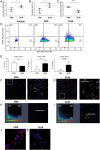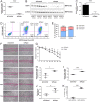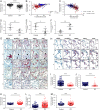Dynamic expression of HOPX in alveolar epithelial cells reflects injury and repair during the progression of pulmonary fibrosis
- PMID: 30154568
- PMCID: PMC6113210
- DOI: 10.1038/s41598-018-31214-x
Dynamic expression of HOPX in alveolar epithelial cells reflects injury and repair during the progression of pulmonary fibrosis
Abstract
Mechanisms of injury and repair in alveolar epithelial cells (AECs) are critically involved in the progression of various lung diseases including idiopathic pulmonary fibrosis (IPF). Homeobox only protein x (HOPX) contributes to the formation of distal lung during development. In adult lung, alveolar epithelial type (AT) I cells express HOPX and lineage-labeled Hopx+ cells give rise to both ATI and ATII cells after pneumonectomy. However, the cell function of HOPX-expressing cells in adult fibrotic lung diseases has not been investigated. In this study, we have established a flow cytometry-based method to evaluate HOPX-expressing cells in the lung. HOPX expression in cultured ATII cells increased over culture time, which was accompanied by a decrease of proSP-C, an ATII marker. Moreover, HOPX expression was increased in AECs from bleomycin-instilled mouse lungs in vivo. Small interfering RNA-based knockdown of Hopx resulted in suppressing ATII-ATI trans-differentiation and activating cellular proliferation in vitro. In IPF lungs, HOPX expression was decreased in whole lungs and significantly correlated to a decline in lung function and progression of IPF. In conclusion, HOPX is upregulated during early alveolar injury and repair process in the lung. Decreased HOPX expression might contribute to failed regenerative processes in end-stage IPF lungs.
Conflict of interest statement
The authors declare no competing interests.
Figures




Similar articles
-
Chronic WNT/β-catenin signaling induces cellular senescence in lung epithelial cells.Cell Signal. 2020 Jun;70:109588. doi: 10.1016/j.cellsig.2020.109588. Epub 2020 Feb 26. Cell Signal. 2020. PMID: 32109549 Free PMC article.
-
TRIM72 promotes alveolar epithelial cell membrane repair and ameliorates lung fibrosis.Respir Res. 2020 May 29;21(1):132. doi: 10.1186/s12931-020-01384-2. Respir Res. 2020. PMID: 32471489 Free PMC article.
-
Serpine 1 induces alveolar type II cell senescence through activating p53-p21-Rb pathway in fibrotic lung disease.Aging Cell. 2017 Oct;16(5):1114-1124. doi: 10.1111/acel.12643. Epub 2017 Jul 19. Aging Cell. 2017. PMID: 28722352 Free PMC article.
-
Regeneration or Repair? The Role of Alveolar Epithelial Cells in the Pathogenesis of Idiopathic Pulmonary Fibrosis (IPF).Cells. 2022 Jun 30;11(13):2095. doi: 10.3390/cells11132095. Cells. 2022. PMID: 35805179 Free PMC article. Review.
-
Alveolar wars: The rise of in vitro models to understand human lung alveolar maintenance, regeneration, and disease.Stem Cells Transl Med. 2020 Aug;9(8):867-881. doi: 10.1002/sctm.19-0433. Epub 2020 Apr 9. Stem Cells Transl Med. 2020. PMID: 32272001 Free PMC article. Review.
Cited by
-
Heterogeneity of Pulmonary Stem Cells.Adv Exp Med Biol. 2019;1169:95-117. doi: 10.1007/978-3-030-24108-7_6. Adv Exp Med Biol. 2019. PMID: 31487021 Free PMC article. Review.
-
Progenitor potential of lung epithelial organoid cells in a transplantation model.Cell Rep. 2022 Apr 12;39(2):110662. doi: 10.1016/j.celrep.2022.110662. Cell Rep. 2022. PMID: 35417699 Free PMC article.
-
PTEN loss regulates alveolar epithelial cell senescence in pulmonary fibrosis depending on Akt activation.Aging (Albany NY). 2019 Sep 17;11(18):7492-7509. doi: 10.18632/aging.102262. Epub 2019 Sep 17. Aging (Albany NY). 2019. PMID: 31527305 Free PMC article.
-
The cortical hem lacks stem cell potential despite expressing SOX9 and HOPX.Dev Neurobiol. 2022 Oct;82(7-8):565-580. doi: 10.1002/dneu.22899. Epub 2022 Sep 20. Dev Neurobiol. 2022. PMID: 36067402 Free PMC article.
-
SARS-CoV-2 infection of human-induced pluripotent stem cells-derived lung lineage cells evokes inflammatory and chemosensory responses by targeting mitochondrial pathways.J Cell Physiol. 2022 Jul;237(7):2913-2928. doi: 10.1002/jcp.30755. Epub 2022 Apr 23. J Cell Physiol. 2022. PMID: 35460571 Free PMC article.
References
-
- Kuroki Y, Voelker DR. Pulmonary surfactant proteins. J Biol Chem. 1994;269:25943–25946. - PubMed
Publication types
MeSH terms
Substances
Grants and funding
LinkOut - more resources
Full Text Sources
Other Literature Sources
Research Materials

